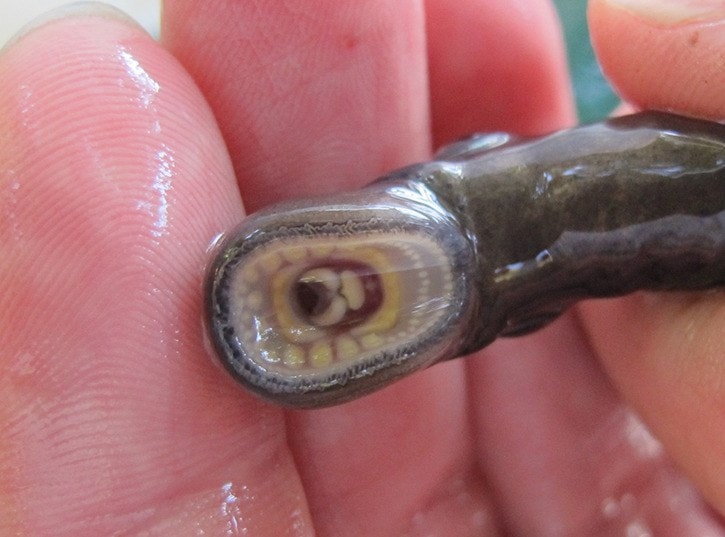Already a rare and threatened species, the Vancouver lamprey — which is only known to exist in Mesachie Lake and Cowichan Lake — faces an imperilled future due to increasingly dry weather.
Catalyst Paper obtained a permit to relocate lampreys in distress around the lake, however, the company’s environment manager recognizes this is not a permanent solution.
The Vancouver lamprey is a species related to the Pacific lamprey, but which has adapted to fresh water. They are a dark, inky colour and have eel-like bodies and round mouths lined with a series of sharp teeth. The Vancouver lamprey ranges in size from 18 to 27 centimetres.
Because of its extremely restricted geographic distribution, it is considered especially susceptible to a number of local threats such as water use and climate change. The lamprey typically lives in the sandy areas where rivers and streams empty into the lake.
In order to obtain a licence to pump water from Cowichan Lake over the weir, Catalyst first needed a section 73 Species at Risk Act permit, promising to manage the potential impact of lower lake levels on the lamprey.
Brian Houle, environment manager for Catalyst, noted the company hired an environmental organization to monitor the Cowichan River earlier this year as reduced water flow over the weir and into the river caused some fish to become stranded in pools.
“As we draw the lake level down, there could be these similar impacts,” he said. “We could isolate bodies of water from the main lake, and by doing so we could impact the fish that didn’t get into the main lake [and are] stranded in those isolated bodies of water.”
The special species at risk permit authorizes qualified environmental professionals hired by Catalyst to handle and move any stranded lampreys, an action that would otherwise be prohibited because of the species’ at-risk status.
“It brings in a very complicated process,” he said.
Bob Crandall, a QEP and member of the Cowichan Lake Salmonid Enhancement Society, said if Catalyst does have to begin pumping water over the weir, the lake is “going to have a lot of exposed sand and shoreline that has not been exposed for a very long time.”
These areas are where lampreys spend most of their lives.
Crandall said lampreys, which sometimes fasten themselves onto larger fish, have unfairly gotten a bad rap.
“A lot of folks say, ‘Yuck! Lampreys, they’re creepy. We don’t like them. They’re eels.’ A lot of people are kind of freaked out by them. But they put a stress on the fish and obviously the fish survive. Does that make the fish stronger? I would think so,” he said.
On Monday, Sept. 19, Fisheries and Oceans Canada hosted an open house in Lake Cowichan to share information on the Vancouver lamprey and to seek input from community members and other stakeholders on a forthcoming action plan that will propose critical habitat protection measures for the Vancouver lamprey.
A DFO spokesperson was not present at the event, and staff were not authorized to provide comments for the media.
In 2007, DFO published a recovery strategy report on the Vancouver lamprey that stated the fish is “unlikely to be purposely transplanted elsewhere in B.C… Recovery actions will be aimed at maintaining or improving current habitat conditions, monitoring the population, and undertaking specific research tasks. With the support of local governments, local industry and the public, recovery is deemed to be technically and biologically feasible.”
